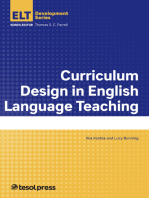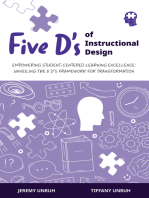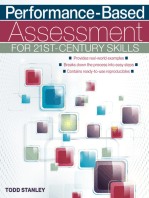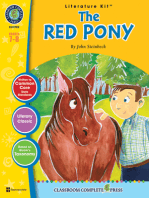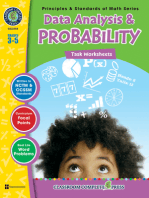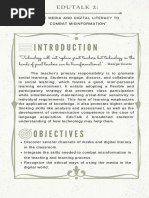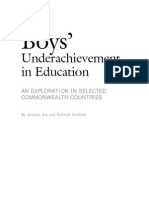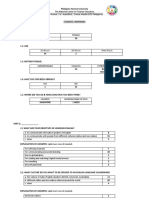Summative Assessment Wwhs
Uploaded by
api-230766638Summative Assessment Wwhs
Uploaded by
api-230766638Grade/Content Area Lesson Title
State Standards: GLEs/GSEs Or Common Core State Standards:
11th Grade ELA Transcendentalism in Your World
CCSS.ELA-Literacy.SL.11-12.1a Come to discussions prepared, having read and researched material under study; explicitly draw on that preparation by referring to evidence from texts and other research on the topic or issue to stimulate a thoughtful, well-reasoned exchange of ideas. CCSS.ELA-Literacy.SL.11-12.2 Integrate multiple sources of information presented in diverse formats and media (e.g., visually, quantitatively, orally) in order to make informed decisions and solve problems, evaluating the credibility and accuracy of each source and noting any discrepancies among the data. CCSS.ELA-Literacy.SL.11-12.3 Evaluate a speakers point of view, reasoning, and use of evidence and rhetoric, assessing the stance, premises, links among ideas, word choice, points of emphasis, and tone used. CCSS.ELA-Literacy.SL.11-12.4 Present information, findings, and supporting evidence, conveying a clear and distinct perspective, such that listeners can follow the line of reasoning, alternative or opposing perspectives are addressed, and the organization, development, substance, and style are appropriate to purpose, audience, and a range of formal and informal tasks. CCSS.ELA-Literacy.SL.11-12.5 Make strategic use of digital media (e.g., textual, graphical, audio, visual, and interactive elements) in presentations to enhance understanding of findings, reasoning, and evidence and to add interest.
Context of the Lesson Opportunities to Learn
Definition: Materials, Learners and Environments
This lesson come towards the end of a unit plan focused on Transcendentalism. Its purpose is to allow students to present their Multimedia transcendentalism projects. Plans to differentiate instruction: I plan to utilize the Multiple Intelligences theory within my classroom in order to best differentiate my instructions to each and every student. Bodily-Kinesthetic: Students will get up and move around as they present their 5 examples. Visual-Spatial: Students will be presented a peer evaluation handout to grade each other. Students will also be presenting their 5 examples with many different types of visuals. Interpersonal: Students will participate in group discussion at the
end of each presentation, posing questions for each presenter. Intrapersonal: Students will be asked to fill out an exit slip with their reflection on the project. This provides students with a chance at privately writing down their thoughts versus sharing them aloud to the class. Verbal-Linguistic: Students will be presenting their 5 examples. Nature: One of the major tenets of Transcendentalism relates specifically to nature. Im certain that many of the examples will relate to nature. Musical: Students will be exposed to all different types of music while their peers are presenting their 5 examples. Accommodations and modifications: Accommodations and modifications will be made for any student with an IEP. For this particular class there is one student with an IEP who may need extended time to complete tasks. That student will be allowed extra time to present his or her project if needed. For the exit slips, the student will be allowed to stay after the bell rings if necessary to finish. Environment factors: The classroom will consist of the desks being separated down the middle and then angled towards the middle of the class. This set up will break up the traditional rows that students are used to. This arrangement will also better serve the presenters. Materials: Peer Evaluation Sheets Project Rubric Project Handout Exit Slips Projector Laptop
Objectives
Students will analyze different forms of media in order to explain their relation to the tenets of transcendentalism. Students will support their explanations with specific evidence. Students will discuss their 5 media examples in order to demonstrate their understanding of transcendentalism and
its presence in the modern world. Students will create a PowerPoint, Prezi, or poster board that creatively shows their 5 different examples. Using a provided peer evaluation sheet, Students will evaluate a peers presentation. Students will question one anothers examples.
Instructional Procedures
Opening: At the start of class students will complete a reflection on a certain quote, just as they do each class. After they have had time to reflect we will briefly share and discuss the quote before moving on to the presentations due to the amount of time they will consume. Do Now Quote: There are always three speeches, for every one you actually gave. The one you practiced, the one you gave, and the one you wish you gave. -Dale Carnegie Engagement: The engagement will focus on student presentation. Each student will take turns presenting his or her 5 examples of transcendentalism within modern society along with a visual aid. Before getting up to present students are required to hand me their rubric in order for me to assess their projects. A missing rubric results in minus 5 points from their final project grade. Once the first presenter is ready I will choose a random student to peer evaluate their presentation. After the presenter is done he/she will peer evaluate the next presenter and so on. This allows for each student to have an opportunity to evaluate one another. After a presenter is finished I will question their examples to generate a small discuss, encouraging other students to ask questions for the presenter. I may ask why students chose certain examples or share a different perspective on certain examples. (I anticipate these presentations to take at least 2 class periods due to the length of time required for each.) Closure: To end class students will fill out a provided exit slip. The exit slip will allow me to assess their understanding of the project and what they got out of it. Students were provided with a rubric when first assigned this project, which highlights the different areas they will be graded on. This rubric ensures that students are fully aware of the scoring
Assessment
criteria for the project and presentation. I will use this rubric while students to present to assess how well they have analyzed and explained their media examples. It will also allow me to assess how well they discuss and support their findings with specific evidence, as well as how well they produce a visual aid. The peer evaluation sheets that students use to evaluate a single peer will allow the students a chance to assess their classmates. This form of assessment gives me a different perspective on their projects. This also allows me to assess how well a student is at peer evaluating. I will use informal questioning after each presentation to briefly discuss their examples, leading to critical thinking. I will also use the exit slips as a way to assess students opinions about the project. Student reflection is an essential part of assessments as it gives me their insight on how to improve the project for the future.
Reflections
This section to be completed only if lesson plan is implemented. Cite RIPTS and national teacher candidate standards here
Due to the difficulty of embedding student work, I provided the individual links to student presentations. Student Work Sample 1 Approaching Proficiency:
Student Work Sample 2 Proficient: http://prezi.com/pnmgfwpxtny3/untitled-prezi/?kw=viewpnmgfwpxtny3&rc=ref-32959047 Student Work Sample 3 Exceeds Proficiency: http://prezi.com/xidgktekawpi/untitled-prezi/?kw=viewxidgktekawpi&rc=ref-32959047
Lesson Implementation: This was one of my most challenging implemented lessons yet. The amount of assessment included within the lesson is great but a lot to implement. I love the amount of assessment that I chose to include: project rubric, peer evaluation sheets, and the exit slips (RIPTS 9.3, 9.4, 9.5). Assessment such as rubrics is my weak point when it comes to education. I felt that the rubric was well designed and clear enough so that students understood what is considered meeting the standard. The two exit slips were great feedback for me(RIPTS 9.7). I was curious if students would just put that they disliked the project due to the presenting in front of the class but less than I thought wrote that down which surprised me. The peer evaluation sheets were a great idea that my cooperating teacher helped me with but I felt that there is much to improve upon both with the questions that I asked such as what is your favorite example and the way that I implemented it. I would have liked to model the peer evaluation process with my students but failed to do so. This would have cleared up any confusion about what I was looking for. My cooperating teacher thought of a great idea on how to better implement peer evaluation in the future: students could utilize the peer evaluations as a way to facilitate the class with questions and discussion(RIPTS 5.1, 6.3, 6.4, 8.4). This is a great idea that I plan on implementing the next time I use peer evaluation. My cooperating teacher also graded the first presentation with the same rubric I used so that we could compare each others assessment(RIPTS 7.1). This proves to be extremely beneficial to me as I can see certain aspects that I may have missed. It also provides me with a different perspective on assessment. (NCTE 2.3) There were a few little things that I didnt like about the lesson such as not including the chart in the rubric or assessment of the project. If I am to teach this lesson again I would ask students to find 5 examples, fill out the chart thoroughly, and then only present 2-3 examples. This would positively impact the time management and how long it takes for each presentation. By having them fill out the chart they would still prove to me that they found 5 examples. I like the effort that students put forth in their presentations but I feel as though less examples and more discussion would have been beneficial. I really disliked having to at times rush through presentations due to time constraints. I would have loved to have students focus on 2-3 examples and critically analyze each example rather than rushing through 5. While using the rubric to grade their presentations I realized there were a few aspects I didnt like myself. The first three rows which deal with the explanations, examples
provided and tenets used seem too confusing the way they are worded. It was difficult to grade a student, for example, who only provided 4 examples but touched upon 8 or more tenets. Its amazing how much you realize about a rubric when you actually use it to grade the student work. Overall most of the students who presented did a phenomenal job and really blew me away. This is my first project that I have assigned as a teacher and it feels good seeing that students enjoyed it for the most part. Directions were a little hard to comprehend for some at first but showing an example of my own seemed to clarify. I will certainly change up the assignment handout to make it a little more clear on what is required such as what is required for the tenets and the explanations. After reading the exit slips most of the students expressed how much they enjoyed being able to choose their own examples (RIPTS 3.1, 10.1, NCTE 2.5, 2.6). I could tell that students were easily able to connect this project to their own life experiences, which made it easier for some to present (RIPTS 4.2). It is evident to me that when students are given more freedom, they are more likely to do an assignment, however with freedom comes responsibility. This project clearly shows NCTE standards 3.2.1 through 3.2.5 as students were given the opportunity to utilize and improve upon their oral, written and visual literacy skills. I plan on utilizing this type of project for my future teaching. Ive realized that I can easily switch out the topic of transcendentalism for something more relevant if needed. This project really had students engaged, something that was evident throughout their presentations. Students were confident in front of the class, even the students who said they were really nervous, because they were talking about examples they chose from their lives. More than half of the students utilized Prezi for their visual aid. I spent one class period with Prezi in showing them the basics of it also allowing them a chance to mess around with it. Im glad that so many students chose to use Prezi. It shows me that students are willing to try new and engaging ideas.
Exit Slip Which one of the major tenets of transcendentalism did you find most difficult to incorporate into your project? Explain.
What did you think of this project? What did you like? What did you dislike? Be honest.
You might also like
- Danielson Aligned Lesson Plan Template For Formal ObservationsNo ratings yetDanielson Aligned Lesson Plan Template For Formal Observations2 pages
- Five D’s of Instructional Design: Empowering Student-Centered Learning Excellence: Unveiling the 5 D's Framework for TransformationFrom EverandFive D’s of Instructional Design: Empowering Student-Centered Learning Excellence: Unveiling the 5 D's Framework for TransformationNo ratings yet
- Creating Activities for Different Learner Types: A Guide for ELT Teachers, Trainers, and WritersFrom EverandCreating Activities for Different Learner Types: A Guide for ELT Teachers, Trainers, and Writers5/5 (1)
- Common Core Snapshot: Administrator's Guide to the Common CoreFrom EverandCommon Core Snapshot: Administrator's Guide to the Common CoreNo ratings yet
- Blueprint For Thoughtful Lesson Planning: Excavating For Conceptual UnderstandingFrom EverandBlueprint For Thoughtful Lesson Planning: Excavating For Conceptual UnderstandingNo ratings yet
- Create an Engaging Syllabus: A Concise, 7-Step Guide for ProfessorsFrom EverandCreate an Engaging Syllabus: A Concise, 7-Step Guide for ProfessorsNo ratings yet
- Using Formative Assessment to Improve Student Outcomes in the ClassroomFrom EverandUsing Formative Assessment to Improve Student Outcomes in the ClassroomNo ratings yet
- Lesson Plan Template EDIS 5882: English Education Name: Amy Zhang ContextNo ratings yetLesson Plan Template EDIS 5882: English Education Name: Amy Zhang Context10 pages
- Motivating for STEM Success: A 50-step guide to motivating Middle and High School students for STEM success.From EverandMotivating for STEM Success: A 50-step guide to motivating Middle and High School students for STEM success.No ratings yet
- The Structured Method of Pedagogy: Effective Teaching in the Era of the New Mission for Public Education in the United StatesFrom EverandThe Structured Method of Pedagogy: Effective Teaching in the Era of the New Mission for Public Education in the United StatesNo ratings yet
- Teaching Literature & Writing in the Secondary School ClassroomFrom EverandTeaching Literature & Writing in the Secondary School ClassroomNo ratings yet
- JUNE Performance-Monitoring-Coaching-FormNo ratings yetJUNE Performance-Monitoring-Coaching-Form6 pages
- Two-Way Table of Specification: Cognitive Domain No. of Items Test Placement KnowledgeNo ratings yetTwo-Way Table of Specification: Cognitive Domain No. of Items Test Placement Knowledge5 pages
- Difficulties in Learning English Faced by The Students Belonging To Rural AreasNo ratings yetDifficulties in Learning English Faced by The Students Belonging To Rural Areas12 pages
- Principles and Methods of Teaching: (Chapter 8)No ratings yetPrinciples and Methods of Teaching: (Chapter 8)23 pages
- JRTE: Journal of Research On Technology in EducationNo ratings yetJRTE: Journal of Research On Technology in Education5 pages
- The Predicting Model of Math Anxiety: The Role of Classroom Goal Structure, Self-Regulation and Math Self-EfficacyNo ratings yetThe Predicting Model of Math Anxiety: The Role of Classroom Goal Structure, Self-Regulation and Math Self-Efficacy6 pages
- Sample Lesson Plan Illustrating One of The Four Major Skills For Communication: Reading 5 or 6No ratings yetSample Lesson Plan Illustrating One of The Four Major Skills For Communication: Reading 5 or 63 pages
- Appendix F-Perceptual-Motor Barriers To LearningNo ratings yetAppendix F-Perceptual-Motor Barriers To Learning4 pages
- Appendix 5A SAT RPMS For T I III SY 2023 2024100% (1)Appendix 5A SAT RPMS For T I III SY 2023 202411 pages
- 360 Degree Feedback Form: Person Being Assessed.No ratings yet360 Degree Feedback Form: Person Being Assessed.5 pages
- Learning and Development Initiatives of WiproNo ratings yetLearning and Development Initiatives of Wipro2 pages
- Curriculum Design in English Language TeachingFrom EverandCurriculum Design in English Language Teaching
- Reading Explorers Year 4: A Guided Skills-Based JourneyFrom EverandReading Explorers Year 4: A Guided Skills-Based Journey
- Reading Explorers Year 2: A Guided Skills-Based JourneyFrom EverandReading Explorers Year 2: A Guided Skills-Based Journey
- Danielson Aligned Lesson Plan Template For Formal ObservationsDanielson Aligned Lesson Plan Template For Formal Observations
- Reading Explorers Year 3: A Guided Skills-Based JourneyFrom EverandReading Explorers Year 3: A Guided Skills-Based Journey
- Academic Presenting and Presentations: Teacher's BookFrom EverandAcademic Presenting and Presentations: Teacher's Book
- Five D’s of Instructional Design: Empowering Student-Centered Learning Excellence: Unveiling the 5 D's Framework for TransformationFrom EverandFive D’s of Instructional Design: Empowering Student-Centered Learning Excellence: Unveiling the 5 D's Framework for Transformation
- Performance-Based Assessment for 21st-Century SkillsFrom EverandPerformance-Based Assessment for 21st-Century Skills
- Creating Activities for Different Learner Types: A Guide for ELT Teachers, Trainers, and WritersFrom EverandCreating Activities for Different Learner Types: A Guide for ELT Teachers, Trainers, and Writers
- Common Core Snapshot: Administrator's Guide to the Common CoreFrom EverandCommon Core Snapshot: Administrator's Guide to the Common Core
- Blueprint For Thoughtful Lesson Planning: Excavating For Conceptual UnderstandingFrom EverandBlueprint For Thoughtful Lesson Planning: Excavating For Conceptual Understanding
- Create an Engaging Syllabus: A Concise, 7-Step Guide for ProfessorsFrom EverandCreate an Engaging Syllabus: A Concise, 7-Step Guide for Professors
- Using Formative Assessment to Improve Student Outcomes in the ClassroomFrom EverandUsing Formative Assessment to Improve Student Outcomes in the Classroom
- Crispin: The Cross of Lead - Literature Kit Gr. 7-8From EverandCrispin: The Cross of Lead - Literature Kit Gr. 7-8
- Lesson Plan Template EDIS 5882: English Education Name: Amy Zhang ContextLesson Plan Template EDIS 5882: English Education Name: Amy Zhang Context
- Reading Explorers Year 6: A Guided Skills-Based JourneyFrom EverandReading Explorers Year 6: A Guided Skills-Based Journey
- Motivating for STEM Success: A 50-step guide to motivating Middle and High School students for STEM success.From EverandMotivating for STEM Success: A 50-step guide to motivating Middle and High School students for STEM success.
- The Cricket in Times Square - Literature Kit Gr. 3-4From EverandThe Cricket in Times Square - Literature Kit Gr. 3-4
- The Structured Method of Pedagogy: Effective Teaching in the Era of the New Mission for Public Education in the United StatesFrom EverandThe Structured Method of Pedagogy: Effective Teaching in the Era of the New Mission for Public Education in the United States
- Data Analysis & Probability - Task Sheets Gr. 3-5From EverandData Analysis & Probability - Task Sheets Gr. 3-5
- Teaching Literature & Writing in the Secondary School ClassroomFrom EverandTeaching Literature & Writing in the Secondary School Classroom
- The Hundred Dresses - Literature Kit Gr. 3-4From EverandThe Hundred Dresses - Literature Kit Gr. 3-4
- Two-Way Table of Specification: Cognitive Domain No. of Items Test Placement KnowledgeTwo-Way Table of Specification: Cognitive Domain No. of Items Test Placement Knowledge
- Difficulties in Learning English Faced by The Students Belonging To Rural AreasDifficulties in Learning English Faced by The Students Belonging To Rural Areas
- JRTE: Journal of Research On Technology in EducationJRTE: Journal of Research On Technology in Education
- The Predicting Model of Math Anxiety: The Role of Classroom Goal Structure, Self-Regulation and Math Self-EfficacyThe Predicting Model of Math Anxiety: The Role of Classroom Goal Structure, Self-Regulation and Math Self-Efficacy
- Sample Lesson Plan Illustrating One of The Four Major Skills For Communication: Reading 5 or 6Sample Lesson Plan Illustrating One of The Four Major Skills For Communication: Reading 5 or 6
